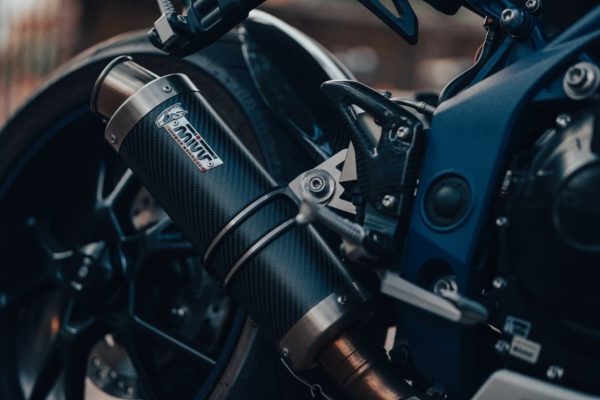Undoubtedly our environment is degrading day by day, and we must protect it. Dealers say your motorbike catalytic converter can protect the environment from harsh gases. But do motorcycle exhausts have catalytic converters? And how do they work?
Nowadays, because of global warming, manufacturers have started manufacturing motorbike exhaust with catalytic converters. But not all motorbikes, such as old motorcycles have exhaust catalytic converters. It’s because of recent regulations introduced in many countries worldwide. In simpler words, you can find exhaust with catalytic converters in all new models.
Let’s look at what it means for you and what you can do about it.
While writing this post, I leave no stone unturned to know how your motorbike exhaust contributes to making the environment green again.
Table of Contents
Do Motorcycle Exhausts Have Catalytic Converters?
With the rapid emission of greenhouse gases, we’ve to make our exhaust clean so no harmful gas can be released.
Fortunately enough, a team of French scientists discovered the catalytic converter way back in the ’90s, which can absorb harmful gases and, governments worldwide took the first step to reducing greenhouse gases emission.
Catalytic converters in the exhaust are relatively new in the field. Thus you can find exhaust with the catalytic converter in new motorbikes easily.
Unfortunately, tons of old motorcycles weren’t used to come catalytic converter exhaust, thus causing a lot of pollution.
Stress not! You can fit catalytic converters in your old motorbike exhaust too.
How Catalytic Converters Work?
So far, you understand why new motorbikes have catalytic converters and not old motorcycles. But have you wondered how catalytic converters work?
Catalytic converters follow the principle of catalysis, which involves converting harmful unburned gasses caused by incomplete combustion to burned and less toxic gases. Catalytic converters mainly focus on carbon monoxide and nitrous oxide gases to form carbon dioxide and less harmful gases.
To understand how the converters work, you should first know some gases released in the combustion.
In the ideal condition, the combustion in your motorbike engine releases carbon dioxide (CO2), water (H2O) with some extent of Nitrogen and Hydrogen.
These gases are less harmful to the environment and don’t contribute much to the greenhouse effect.
In a real-life situation, the case is not so ideal.
Because of lack of air and sometimes low fuel quality, your motorbike suffers from incomplete combustion, releasing harmful gases like carbon monoxide (CO) and nitrous oxide (NO).
These gases are relatively harmful to our environment and cause a greenhouse effect causing our glaciers to melt.
And here, the catalytic converter comes into play.
Catalytic converters have catalysts in them which adds lost H (hydrogen atom) in CO (carbon monoxide) to form CO2 (carbon dioxide).
This same principle applies to all other gases; catalytic converters add extra Oxygen molecules to make gases less harmful.
Because of the nature of catalytic converters to convert greenhouse gases to less harmful gases, people call the whole system a catalytic converter.
What do Catalytic Converters contain?
So far, you understand what motorcycle catalytic converters are and how they work. Now the question is, what do catalytic converters contain?
Catalytic converters mainly contain two parts; the first is ceramic, and the second is rare elements that perform catalysis. Although ceramic doesn’t perform any activity, it gives the heating environment, which is crucial for catalytic converters to perform well. While rare elements act as a reduction catalyst.
The catalysis converters have two working parts, which are crucial for any converter to work fine.
The most significant disadvantage of a catalytic converter is that it can’t perform in cold conditions. And to tackle this problem, manufacturers are starting to fit ceramic which makes the converter temperature high.
Ceramic doesn’t do anything, but it facilitates the ideal environment (high temperature) to work fine.
On the other hand, rare metals such as Palladium, Platinum, and Rhodium act as catalysis agents responsible for changing harmful gases to less dangerous gases.
I’ve mentioned the proper working of the converter above.
For better understanding, see the below YouTube video:
Can you Install Catalytic Converters?
So far, you understand how converters and converters work, but the problem is old motorbikes don’t contain catalytic converters.
To save the environment, one can install catalytic converters on their motorbike separately. But it’s a bit tech and may require specialization, and that’s why experts always recommend hiring a technician to do this work. Additionally, always install converters that are made for your motorbike.
Also, don’t forget to check the fuel and exhaust tube when installing converters, as a blockage may cause incomplete combustion.
How Much Does it Cost to Install Catalytic Converters?
Now you know that you can install motorbike catalytic converters on your old motorbike too? Now the question arises, how much will it cost?
On average, the motorbike catalytic converter will cost you around $100. However, this average will vary from location to location. For example, in Washington, it will cost you more than the average price, while in West Virginia, it will cost you less. Also, converters with more rare metals will be more expensive.
The above-average price of a catalytic converter doesn’t include technician costs.
Is it Illegal to Remove Catalytic Converters?
We all want to protect ourselves from the fine and penalties, and when it’s about our motorbike, we’ve to be more conscious.
As of now, there’s no law regarding catalytic converters in the USA. While in some European countries, you’ve to pay some penalties if your motorbike exhaust doesn’t have catalytic converters in it. But this doesn’t mean you shouldn’t install catalyst converters on your motorbike.
Don’t forget to start small to save the environment.
Also, read my previous post where I’ve discussed should you clean your motorbike exhaust. Click here to read.
Do Catalytic Converters Really Work?
There’s an entirely new trend in the market for installing motorbike catalytic converters into your motorbike. But does the catalyst really work? Or it’s just another hype.
Catalytic converters reduce greenhouse gases emission from your motorbike, thus saving the environment. But catalytic converters need around 600 F to work correctly. It means converters won’t work until your motorbike reaches 600 F. For the first 30 minutes, your motorbike converter won’t convert greenhouse gases to clean gases.
It’s the most significant disadvantage of converters, that’s why it’s recommended to leave your motorbike starting for around 15 minutes.
In simpler words, your motorbike converters won’t work if you ride a short ride.
You can read the book “Air Pollution from motor vehicles.” Click here to read. For better understanding, you can see table 3.2 on page number 75
.
How Can You Maximize the Benefit of Catalytic Converter?
So far, you understand some disadvantages of converters, but have you ever wondered how you can maximize the benefits of converters?
Here are some ways through which you can maximize the benefits of a converter.
Use Unleaded Fuel:
Standard gasoline contains lead which causes harmful gases emission. You can’t remove lead from gasoline.
And that’s why it’s better to choose gasoline which comes with less lead quantity.
Go for Regular Maintenance:
Undoubtedly maintenance is a must for your motorbike engine. Maintenance not only helps to increase motorbike age.
But it also helps you to clean your motorbike fuel as well as the exhaust tube. Always remember, a clean tube helps to promote complete combustion, thus promoting the excellent gas release.
Frequently Asked QUestions:
How catalytic converters works?
Catalytic converters follow the principle of catalysis, which involves converting harmful unburned gasses caused by incomplete combustion to burned and less toxic gases
What do catalytic converters contain?
Catalytic converts mainly contain two parts; the first is ceramic, and the second is rare elements that perform catalysis.
Can you install catalytic converters?
To save the environment, one can install catalytic converters on their motorbike separately. But it’s a bit tech and may require specialization.
What’s the minimum cost for installing catalytic converters?
On average, the motorbike catalytic converter will cost you around $100. However, this average will vary from location to location.
Is it illegal to remove catalytic converters?
Catalytic converters reduce greenhouse gases emission from your motorbike, thus saving the environment. But catalytic converters need around 600F to work correctly.
Final Verdict:
Do Motorcycle Exhausts have Catalytic Converters? Nowadays, because of global warming, manufacturers have started manufacturing motorbike exhaust with catalytic converters.
But not all motorbikes, such as old motorcycle exhaust catalytic converters. It’s because of recent regulations introduced in many countries worldwide. In simpler words, you can find exhaust with catalytic converters in all new models.
I’ve mentioned some ways above through which you can increase the benefit of exhaust. Don’t forget to check out and implement all those.
John, this side! My passion for motorbikes started when I was 12. I experienced many accidents and even lost some friends too. And it inspired me to create this website so that no parents in this world would lose their child while enjoying riding.


